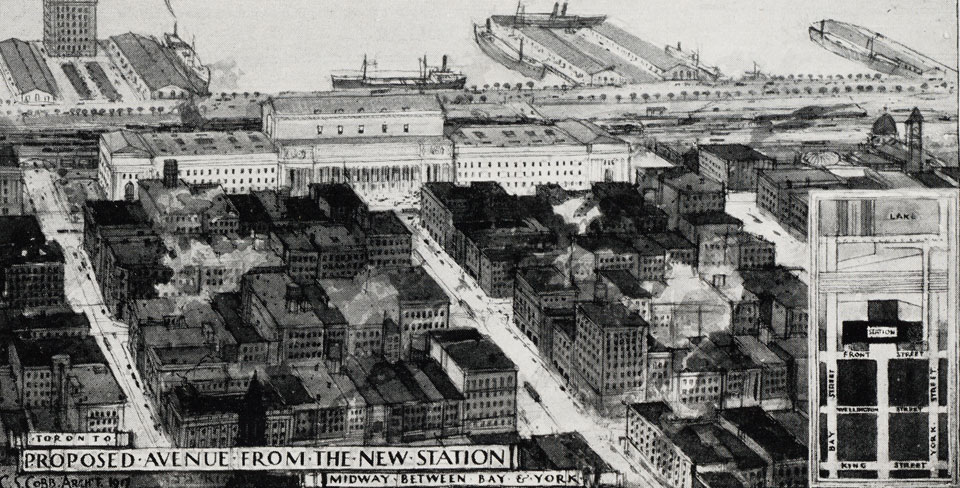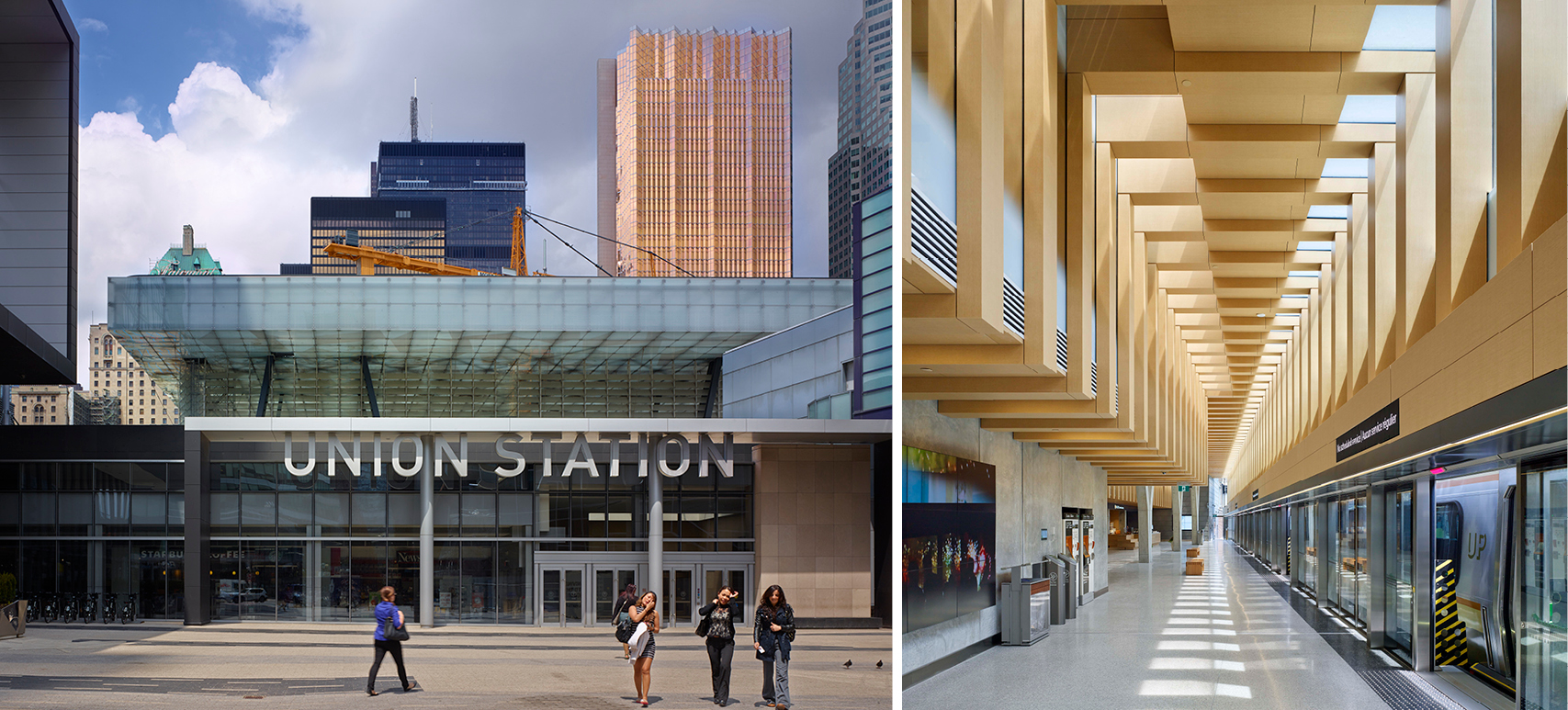Location: Toronto, Ontario
Date of Completion: 1927
Architect: Ross and MacDonald, Hugh Jones (Assistant Chief Architect, Canadian Pacific Railway) and John M. Lyle Architect
Dates of Renovation/Addition:1970s, 2022
Architects of Renovation/Addition: (2022) NORR Architects & Engineers Limited, EVOQ Architecture Inc., Zeidler Architecture, PARTISANS (interior), IBI Group (second platform)
Nominated by: Chris Glover, MPP (Spadina—Fort York)
“You build your stations like we build our cathedrals.”
Edward, Prince of Wales
August 6, 1927 at the Opening of Union Station
One of Canada’s finest examples of Beaux-Arts architecture, Toronto’s Union Station has served as the city’s grand gateway for almost a century—welcoming millions of visitors and commuters every year and playing a critical role in shaping the city we see today.
An Architectural Icon
The largest and most ornate of Canada’s grand railway stations, Union Station is exemplary of Beaux-Arts architecture, the early 1900s architectural style of choice for grand civic buildings like libraries, courthouses, and—of course—train stations. Emerging from the École des Beaux-Arts in Paris and strongly borrowing from Greek and Roman architecture, the style is characterized by its monumentality and use of classical ornamentation, as well as its symmetry and careful sequencing of interior spaces.
At Union Station, the monumentality is immediately apparent. The station’s headhouse—that is, the portion of the building hosting ticket booths and Great Hall—is fronted by a five-storey tall grand colonnade of 18 Doric columns. On either side of the central space, a pair of identical wings provide space for offices and a postal station and maintain the symmetry of structure. At the time of construction, Front Street was widened and the station set back by 70 feet to ensure its scale could be fully appreciated. In keeping with Beaux-Arts careful consideration for sequence, entrances are clearly marked with projecting pediments and forward-stepping columns. The original design called for sculptures over the entrances, but these were never implemented due to costs.
 The Great Hall at Union Station looking east. Photo: iStock.com/AndresGarciaM
The Great Hall at Union Station looking east. Photo: iStock.com/AndresGarciaM
Inside, Union’s Station Great Hall is perhaps one of the grandest rooms in all of Canada. Inspired by the Roman Baths of Caracalla, the Hall is a vast open multi-storey space decorated in restrained classical language and topped with a beautiful ceiling of coffered Guastavino tiles. Continuing the Beaux-Art emphasis on sequence of spaces, centrally placed Corinthian columns on the south side of the room clearly indicate the entrance to the train platforms just beyond.
 Union station from above. Photo: Courtesy of Toronto Public Library.
Union station from above. Photo: Courtesy of Toronto Public Library.
A City-Building Catalyst
More than just a standalone building, Union Station was conceived to play an important role in city-building, a role it continues to play to this day.
Designed after the Great Fire of 1904 that consumed much of what we now call the Financial District, Union Station’s monumentality was inspired by the City Beautiful movement as part of a new vision for Toronto. In vogue from the 1890s to the early 1900s, this North American architectural and urban design reform philosophy aimed at improving urban life through the beautification and monumental grandeur of the built environment, which in turn was meant to elevate moral and civic virtue amongst the population. While its ideas inspired many great plans for Toronto, very few proposals were ever actually built.
This city-building role continues to this day as Union Station plays a central role in the redevelopment of the lands around it. With an average of 200,000 daily passengers and around 70 million users a year, Union Station is Canada’s busiest transportation hub with the majority of its passengers being commuters from all across the Greater Toronto Area coming in and out of the city for work. This workforce mobilization has catalysed massive change in the area around the station, particularly in what is now known as the South Core, where rail yards have given way to new office buildings, event spaces, and apartments. A new south entrance to Union station opened in 2010, recognizing the tens of thousands of passengers that now make their way into this previously underused downtown area.
 Left, new south entrance to Union Station. Right, new platform for Union Pearson Express. Photos:
Left, new south entrance to Union Station. Right, new platform for Union Pearson Express. Photos:
The new south entrance is just a small part of the many changes Union Station is undergoing to better serve this massive commuter population. Starting in 2010, the station has been undergoing a multi-year revitalization that seeks to further increase capacity while restoring much of the station’s grand architecture. Included in this work is opening an entire new underground floor with food, retail, and other services, as well as replacing the central portion of the train shed with a new glass canopy to improve daylighting and passenger experience. A new express connection to Toronto’s Pearson International Airport further underlines the station’s important role as a central transportation hub. And all of this new work is being done within the framework of restoring the station’s historic architecture, bringing an exciting mix of new and old as Union Station prepares for the next chapter in its history.
This post forms part of our World Architecture Day Queen’s Park Picks 2022 series in which the OAA asked Ontario’s Members of Provincial Parliament (MPPs) to nominate a prominent building, past or present, in their riding for a chance to learn more about it. Check out the rest of the series to learn more about great buildings across the province!